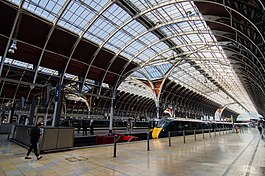
Back بادنغتون (محطة مترو أنفاق لندن) Arabic محطة بادينجتون ARZ লন্ডন প্যাডিংটন স্টেশন Bengali/Bangla Estació de London Paddington Catalan Gorsaf reilffordd Paddington Llundain Welsh Paddington Station Danish Bahnhof Paddington German Paddington (stacidomo) Esperanto Estación de Paddington Spanish Paddington geltokia Basque
| Paddington | |
|---|---|
| London Paddington | |
 The Victorian train shed at Paddington in October 2018 | |
| Location | Paddington |
| Local authority | City of Westminster |
| Managed by | Network Rail |
| Owner | Network Rail |
| Station code(s) | PAD, QQP (IATA) |
| DfT category | A |
| Number of platforms | 15 |
| Accessible | Yes[1] |
| Fare zone | 1 |
| OSI | Paddington Bakerloo, Circle and District lines station Paddington Circle and Hammersmith & City lines station Marylebone Lancaster Gate |
| Cycle parking | Yes |
| Toilet facilities | Yes |
| London Underground annual entry and exit | |
| 2018 | |
| 2019 | |
| 2020 | |
| 2021 | |
| 2022 | |
| National Rail annual entry and exit | |
| 2018–19 | |
| – interchange | |
| 2019–20 | |
| – interchange | |
| 2020–21 | |
| – interchange | |
| 2021–22 | |
| – interchange | |
| 2022–23 | |
| – interchange | |
| Railway companies | |
| Original company | Great Western Railway |
| Key dates | |
| 4 June 1838 | Temporary station opened |
| 29 May 1854 | Permanent station opened |
| 24 May 2022 | Elizabeth line opened |
| Other information | |
| External links | |
| Coordinates | 51°31′02″N 0°10′39″W / 51.5173°N 0.1774°W |
Paddington, also known as London Paddington, is a London railway station and London Underground station complex, located on Praed Street in the Paddington area. The site has been the London terminus of services provided by the Great Western Railway and its successors since 1838. Much of the main line station dates from 1854 and was designed by Isambard Kingdom Brunel. As of the 2022–23 Office of Rail & Road Statistics, it is the second busiest station in the United Kingdom, after London Liverpool Street, with 59.2 million entries and exits.[9]
Paddington is the London terminus of the Great Western Main Line; passenger services are primarily operated by Great Western Railway, which provides commuter and regional passenger services to west London and the Thames Valley region, as well as long-distance intercity services to South West England and South Wales. The station is also the eastern terminus for Heathrow Express and the western terminus for Elizabeth line services from Shenfield. Elizabeth line services also run through Paddington westwards to Reading, Heathrow Terminal 5, and Heathrow Terminal 4, and eastwards to Abbey Wood.[10] Situated in fare zone 1, it has two separate tube stations providing connections to the Bakerloo, Circle, District, and Hammersmith & City lines. It is one of 11 London stations managed directly by Network Rail.
The station has been perennially popular for passengers and goods, particularly milk and parcels. Major upgrades took place in the 1870s, the 1910s and the 1960s, each trying to add additional platforms and space while trying to preserve the existing services and architecture as much as possible. Paddington was first served by London Underground trains in 1863, as the original western terminus of the Metropolitan Railway, the world's first underground railway. In the 20th century, suburban and commuter services appeared at Paddington as the urban sprawl of London moved westwards. Despite the numerous upgrades and rebuilding, plus damage sustained in particular during World War II, Brunel's original design is still recognisable.
- ^ "London and South East" (PDF). National Rail. September 2006. Archived from the original (PDF) on 6 March 2009.
- ^ "Out-of-Station Interchanges" (XLSX). Transport for London. 24 May 2022. Retrieved 5 June 2022.
- ^ "Station Usage Data" (CSV). Usage Statistics for London Stations, 2018. Transport for London. 23 September 2020. Archived from the original on 14 January 2023. Retrieved 11 October 2023.
- ^ "Station Usage Data" (XLSX). Usage Statistics for London Stations, 2019. Transport for London. 23 September 2020. Archived from the original on 9 November 2020. Retrieved 9 November 2020.
- ^ "Station Usage Data" (XLSX). Usage Statistics for London Stations, 2020. Transport for London. 16 April 2021. Retrieved 1 January 2022.
- ^ "Station Usage Data" (XLSX). Usage Statistics for London Stations, 2021. Transport for London. 12 July 2022. Retrieved 7 September 2022.
- ^ "Station Usage Data" (XLSX). Usage Statistics for London Stations, 2022. Transport for London. 4 October 2023. Retrieved 10 October 2023.
- ^ a b c d e f g h i j "Estimates of station usage". Rail statistics. Office of Rail Regulation. Please note: Some methodology may vary year on year.
- ^ "Office of Rail & Road Statistics 2022–23" (PDF). Retrieved 22 March 2024.
- ^ Lydall, Ross (4 May 2022). "Crossrail opening date finally announced". Evening Standard. London.
© MMXXIII Rich X Search. We shall prevail. All rights reserved. Rich X Search
